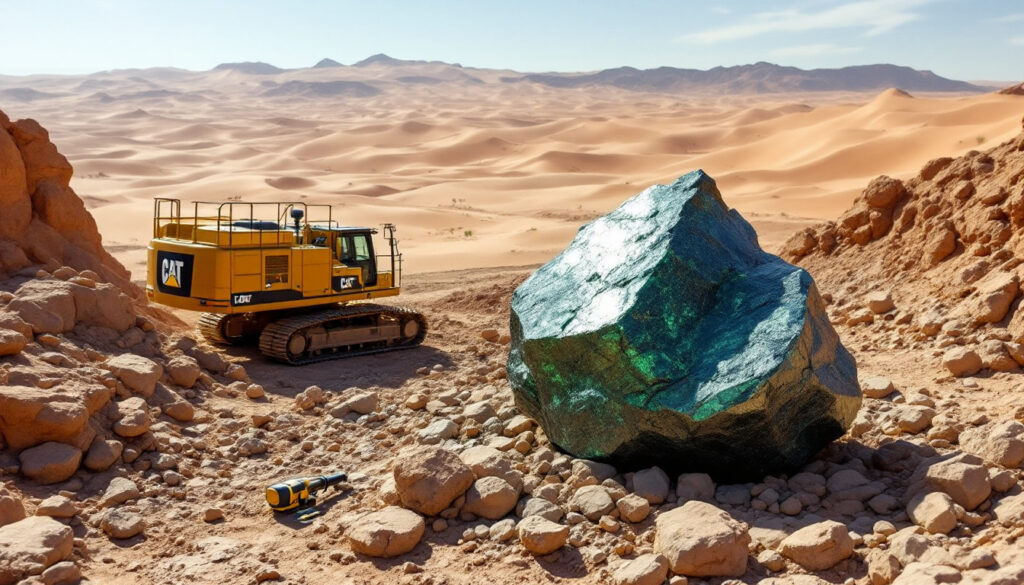The World's Ten Largest Uranium Mines by Production
The global uranium mining landscape consists of a complex network of operations spanning several continents, with the largest mines producing thousands of tonnes annually to fuel the world's nuclear power plants. These top producers are concentrated in just a few countries, with each mine employing specialized extraction techniques suited to their unique geological conditions. Understanding these mining giants provides valuable insight into the global nuclear fuel supply chain that powers approximately 10% of the world's electricity.
What Makes a Uranium Mine Significant in Global Production?
Uranium mines vary significantly in their production capacity, reserve size, ore grade, and extraction methodologies. What truly distinguishes the world's largest operations isn't just their annual output, but also factors like operational efficiency, environmental management, and remaining lifespan.
Understanding Uranium Mining Operations
Uranium mining employs several distinct extraction methods, each selected based on deposit characteristics and economic considerations. Underground mining is typically used for deeper, high-grade deposits like those in Canada's Athabasca Basin, where radiation protection requires specialized equipment and remote operation technologies. Open-pit mining provides access to shallower deposits but requires managing larger volumes of waste rock. In-situ leaching (ISL), the dominant method in Kazakhstan, involves pumping oxygenated solutions directly into permeable ore bodies to dissolve uranium, which is then recovered at the surface.
The industry operates with high technological sophistication, particularly regarding radiation safety protocols and water management. Each mining method presents unique environmental challenges, from groundwater protection in ISL operations to tailings management in conventional mining. Leading mines typically employ state-of-the-art monitoring systems and reclamation planning.
Global Uranium Production Landscape
According to GlobalData, more than 97 uranium mines operate globally, collectively producing the fuel needed for nuclear power generation. These mines vary dramatically in size and output, with the largest operations producing several thousand tonnes annually. Production is measured in tonnes of uranium (tU), with the top ten mines collectively accounting for approximately 38,160 tonnes in 2023—a significant portion of global uranium production.
The economics of uranium mining is complex, with operations requiring substantial capital investment and often operating on decade-long timeframes. Unlike many commodity metals, uranium prices have historically been volatile, influenced by geopolitical events, nuclear policies, and strategic stockpiling behaviors by utilities and governments.
Where Are the World's Largest Uranium Mines Located?
The geographic distribution of major uranium producers reveals interesting patterns of resource concentration and strategic investment. While uranium deposits exist worldwide, economically viable large-scale operations are clustered in relatively few regions.
Geographic Distribution of Major Uranium Producers
The world's ten largest uranium mines are primarily concentrated in four countries: Kazakhstan, Canada, Namibia, and Australia. Kazakhstan leads with four mines in the top ten, leveraging its extensive sedimentary uranium deposits amenable to cost-effective ISL techniques. Canada hosts two of the largest operations, including the world's top producer, characterized by exceptionally high-grade ore bodies that can exceed 20% uranium content—hundreds of times richer than typical deposits.
Namibia's two entrants in the top ten reflect the country's growing importance in the uranium sector, while Australia's Olympic Dam represents a unique case where uranium is produced as a by-product of copper mining. This geographic concentration demonstrates how geological factors, investment patterns, and regulatory environments have shaped the contemporary uranium supply landscape.
Key Mining Companies in the Uranium Sector
Major uranium mining companies exercise significant influence over global production. Kazatomprom, Kazakhstan's national atomic company, operates several of the largest mines and leads global uranium production. Canada's Cameco controls two of the top-producing mines, including Cigar Lake, the world's largest. French multinational Orano maintains a diversified portfolio including operations in Kazakhstan and Niger.
Chinese state-owned enterprises have emerged as major players, with China National Nuclear Corporation and China General Nuclear Power Group acquiring significant assets in Africa. This ownership pattern reflects China's strategic push to secure uranium investment opportunities for its rapidly expanding domestic nuclear power program, which includes plans for over 150 reactors by 2035.
10. SOMAIR Mines (Niger)
Mine Overview and Production Capacity
The SOMAIR (Société des Mines de l'Aïr) operation in Niger's Arlit region produced approximately 2,390 tonnes of uranium in 2023, securing its position as the tenth-largest uranium producer globally. This surface mining operation extracts uranium from sedimentary deposits using conventional open-pit methods that have been refined over decades of operation.
SOMAIR is operated by Orano (formerly Areva), which holds a 63.4% stake, with the remaining 36.6% owned by Niger's government through SOPAMIN (Société du Patrimoine des Mines du Niger). The mine's significance extends beyond production numbers; it represents one of Africa's longest-running uranium operations and a cornerstone of Niger's mining sector.
Operational Details and Future Outlook
Classified as a brownfield mine with well-established infrastructure, SOMAIR's operations face challenges including security concerns in the Sahel region and fluctuating uranium prices. The operation employs approximately 800 workers and utilizes a processing facility with acid leaching technology to extract uranium from ore averaging 0.3% uranium content.
Production is expected to continue until 2032, though exploration activities aim to extend this timeframe. The mine's future is closely tied to Niger's political stability and global uranium market trends. Recent military coups in Niger have raised questions about the regulatory environment, though operations have continued with minimal disruption.
9. Akdala Mine (Kazakhstan)
Mine Overview and Production Capacity
Kazakhstan's Akdala Mine produced an estimated 2,490 tonnes of uranium in 2023 through in-situ leaching operations. Located in the South Kazakhstan province, this facility exemplifies the country's leadership in ISL technology, which has transformed global uranium production economics since the early 2000s.
The mine is operated by JV Southern Mining and Chemical Company LLP, with ownership shared between Kazatomprom (70%) and Energy Asia Limited (30%). Akdala's production represents part of Kazakhstan's broader strategy to leverage its extensive sedimentary uranium deposits through low-cost extraction methods.
Operational Details and Future Outlook
Classified as a greenfield mine despite operating since 2006, Akdala uses advanced wellfield designs and processing facilities to recover uranium from permeable sandstone formations. The operation consists of multiple wellfields where oxygenated solutions circulate through uranium-bearing sands at depths between 200-700 meters.
With closure expected in 2025, Akdala represents the shorter end of mine life cycles among top producers. The operation employs approximately 400 personnel and maintains strict environmental monitoring of groundwater conditions. Kazakhstan's uranium sector faces challenges including maintaining ISL wellfield productivity and navigating changing international partnerships following Western sanctions on Russia.
8. Karatau Mine (Kazakhstan)
Mine Overview and Production Capacity
The Karatau Mine in Kazakhstan's Suzak district produced approximately 2,580 tonnes of uranium in 2023. This in-situ recovery operation targets uranium mineralization in Paleogene sandstone formations within the Chu-Sarysu basin, one of Kazakhstan's most productive uranium provinces.
Owned by Kazatomprom, Kazakhstan's national atomic company and the world's largest uranium producer, Karatau represents part of the company's portfolio of ISL operations that collectively account for over 20% of global uranium production. The mine operates with minimal surface disruption compared to conventional mining methods.
Operational Details and Future Outlook
As a brownfield mine with established infrastructure, Karatau employs approximately 450 workers and utilizes sophisticated wellfield management systems to maintain production efficiency. Operations involve a network of injection and recovery wells that circulate leaching solutions through uranium-bearing sandstones.
Production is expected to continue until 2032, with potential for extension through adjacent resource development. Kazakhstan's uranium industry benefits from relatively low production costs, with Karatau's expenses estimated at £12-15 per pound of uranium—significantly below the global average of £40-45 per pound for conventional mining operations.
7. Rossing Mine (Namibia)
Mine Overview and Production Capacity
The Rossing Mine, located in Namibia's Erongo region, produced an estimated 2,670 tonnes of uranium in 2023. This extensive open-pit operation, which began production in 1976, makes it one of the world's longest-operating uranium mines. The facility processes approximately 20 million tonnes of rock annually to recover its uranium output.
Ownership transitioned to China National Nuclear Corporation (CNUC) in 2019, which acquired a 68.62% stake from Rio Tinto. The remaining ownership is divided between the Namibian government (3%), the Iranian Foreign Investment Company (15%), and individual shareholders (13.38%). This ownership structure reflects the strategic value placed on uranium resources by countries with extensive nuclear power development plans.
Operational Details and Future Outlook
Rossing employs conventional open-pit mining methods to extract uranium from alaskite granite containing relatively low-grade ore (0.03% uranium oxide). The operation encompasses a mining area covering approximately 25 square kilometers, with ore processing facilities including crushing, grinding, and acid leaching circuits.
With operations scheduled to continue until 2035, Rossing has implemented innovative water conservation practices, including a seawater desalination plant to reduce freshwater consumption in Namibia's arid environment. The mine employs approximately 1,000 workers and contributes significantly to Namibia's export earnings and tax revenue.
6. Tortkuduk Mine (Kazakhstan)
Mine Overview and Production Capacity
Kazakhstan's Tortkuduk Mine produced approximately 2,750 tonnes of uranium in 2023 through in-situ leaching operations. Located in the Chu-Sarysu basin, the mine targets uranium mineralization in Paleogene and Cretaceous sandstone formations at depths between 400-750 meters.
The operation is owned by KATCO, a joint venture between French nuclear fuel company Orano (51%) and Kazatomprom (49%). This partnership represents one of the most significant foreign investments in Kazakhstan's uranium sector and demonstrates the international collaboration that characterizes modern uranium production.
Operational Details and Future Outlook
As a greenfield mine established in 2007, Tortkuduk employs advanced automation and wellfield management systems. The operation utilizes a sulfuric acid leaching process optimized for the carbonate-rich host formations and employs approximately 500 personnel.
Operations are expected to continue until 2033, with ongoing wellfield development sustaining production levels. The mine has pioneered several technological innovations in ISL mining, including improved well completion techniques and advanced process control systems that maintain Kazakhstan's cost advantage in global uranium production.
5. Inkai Mine (Kazakhstan)
Mine Overview and Production Capacity
The Inkai Mine produced an estimated 3,230 tonnes of uranium in 2023, making it Kazakhstan's largest uranium producer. This extensive in-situ leaching operation in South Kazakhstan province targets uranium mineralization in Paleogene sandstone formations with grades averaging 0.04% uranium.
The ownership structure includes Kazatomprom (60%) and Canada's Cameco Corporation (40%), representing a significant international partnership in uranium production. The mine has been operating since 2009, with subsequent expansions increasing its production capacity substantially.
Operational Details and Future Outlook
As a brownfield mine with operations projected to continue until 2045, Inkai represents one of Kazakhstan's most substantial uranium assets. The operation spans multiple wellfields covering approximately 139 square kilometers, with processing facilities capable of handling recovered uranium solutions from thousands of active wells.
The mine employs approximately 750 personnel and utilizes state-of-the-art monitoring systems to manage environmental impacts, particularly groundwater conditions. Recent investments in processing technology have increased recovery efficiency and reduced chemical consumption, enhancing the operation's cost-competitiveness in international markets.
4. Olympic Dam Mine (Australia)
Mine Overview and Production Capacity
Australia's Olympic Dam Mine produced approximately 3,410 tonnes of uranium in 2023 as a by-product of copper mining. Located in South Australia, this unique polymetallic deposit represents one of the world's largest resource bodies, containing an estimated 2.1 million tonnes of uranium oxide reserves alongside massive copper, gold, and silver resources.
The operation is wholly owned by BHP Group, one of the world's largest diversified mining companies. Unlike dedicated uranium mines, Olympic Dam's primary focus is copper production, with uranium extraction representing a valuable secondary revenue stream. This operational model provides cost advantages as mining infrastructure serves multiple metal recovery circuits.
Operational Details and Future Outlook
Olympic Dam utilizes underground mining methods at depths exceeding 500 meters to access ore bodies containing approximately 0.03% uranium oxide. The processing flow includes crushing, grinding, flotation of copper minerals, and separate leaching of uranium from tailings materials.
As a greenfield mine with operations projected to continue until 2081, Olympic Dam has one of the longest operational horizons in the industry. The facility employs approximately 3,500 personnel across mining and processing divisions. Recent technological improvements include automated haulage systems and enhanced radiation monitoring protocols.
BHP has investigated several expansion scenarios that could potentially double uranium production, though these projects remain under evaluation pending market conditions and capital allocation decisions. The mine's exceptionally long operational life ensures Australia's continued importance in global uranium supply despite having only one entry among the top producers.
3. Husab Uranium Mine (Namibia)
Mine Overview and Production Capacity
The Husab Uranium Mine produced an estimated 4,900 tonnes of uranium in 2023, making it Africa's largest uranium producer. Located in Namibia's Erongo region approximately 5 kilometers from the Rossing Mine, Husab operates as a conventional open-pit mining operation extracting uranium from granite-hosted deposits similar to those at Rossing.
The mine is 90% owned by China General Nuclear Power Corporation (CGN) through its subsidiary Swakop Uranium, with the remaining 10% held by the Namibian government through Epangelo Mining Company. This ownership structure reflects China's strategic expansion into African uranium resources to secure supplies for its domestic nuclear power program.
Operational Details and Future Outlook
As a brownfield mine commissioned in 2016, Husab represents one of the newest large-scale uranium operations globally. The mine's development required capital investment exceeding $4.8 billion—the largest single Chinese investment in Africa at the time of construction. Operations involve two separate open pits (Zones 1 and 2) with ore processing through acid leaching and solvent extraction.
With operations expected to continue until 2040, Husab processes approximately 15 million tonnes of ore annually from reserves containing 0.035% uranium oxide. The operation employs over 1,600 workers and has established extensive environmental management systems addressing water conservation, dust control, and radiation protection.
2. McArthur River Mine (Canada)
Mine Overview and Production Capacity
Canada's McArthur River Mine produced approximately 6,350 tonnes of uranium in 2023, making it the second-largest uranium producer globally. Located in northern Saskatchewan's Athabasca Basin, this underground operation extracts exceptionally high-grade uranium ore averaging 8% U₃O₈—approximately 100 times higher than most uranium mines worldwide.
The ownership structure includes Cameco Corporation (69.8%) and Orano Canada Inc. (30.2%). McArthur River exemplifies the technological sophistication required for mining ultra-high-grade uranium deposits, where radiation protection necessitates remote-controlled equipment and specialized ventilation systems.
Operational Details and Future Outlook
With operations projected to continue until 2048, McArthur River represents a long-term, high-grade uranium resource. The mine employs approximately 750 workers and utilizes innovative mining methods including raise-bore and blasthole stoping with freeze wall protection to prevent water inflow.
The operation's history includes a suspension between 2018-2022 in response to weak uranium prices, demonstrating the market sensitivity that characterizes even the world's most productive mines. Current operations have been optimized to reduce costs while maintaining strict safety and environmental standards. Ore is processed at the Key Lake mill located 80 kilometers south, with tailings management facilities designed for long-term stability.
1. Cigar Lake Project (Canada)
Mine Overview and Production Capacity
The Cigar Lake Project, located in Saskatchewan's Athabasca Basin, produced an estimated 7,390 tonnes of uranium in 2023, securing its position as the world's largest uranium producer. This underground operation extracts ore from deposits containing the highest uranium grades globally, averaging 15.6% U₃O₈—approximately 100 times richer than typical mines.
The ownership structure includes Cameco (54.5%), Orano Canada Inc. (40.5%), Idemitsu Canada Resources (7.9%), and TEPCO Resources (5.0%). Cigar Lake represents the pinnacle of technological innovation in uranium mining, employing methods developed specifically for its unique geological challenges.
Operational Details and Future Outlook
As a greenfield mine with operations expected to continue until 2032, Cigar Lake uses jet-boring technology that freezes the ore body and surrounding rock to prevent water inflow and contain radiation. This innovative approach allows remote extraction of exceptionally high-grade ore without direct worker exposure to the deposit.
The mine employs approximately 600 personnel,
Ready to Discover the Next Major Mining Opportunity?
Stay ahead of the market with Discovery Alert's proprietary Discovery IQ model, which instantly notifies investors of significant ASX mineral discoveries across uranium and 30+ other commodities. Visit our discoveries page to understand how major mineral discoveries can lead to exceptional returns and begin your 30-day free trial today.




